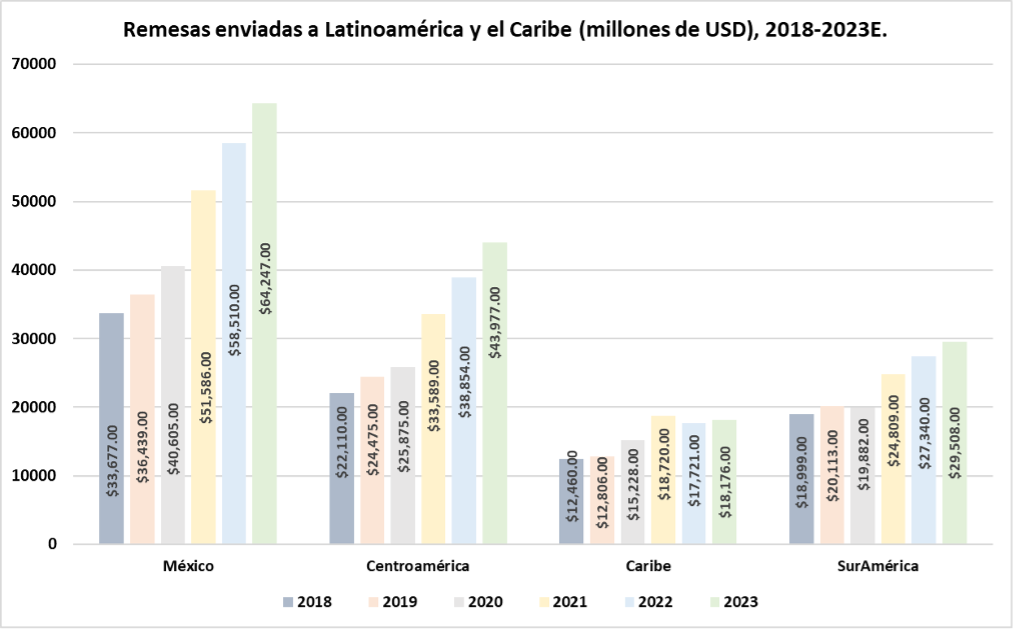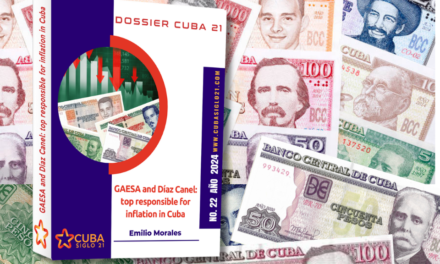Descargar informe completo en pdf (Español)
Download report pdf (English)
Resumen en español
The year 2023 has been chaotic for the Cuban regime’s finances. In the month of December, the dollar reached 280 CUP on the black market, setting a record in the inflationary spiral of the collapsed Cuban economy. Meanwhile, a massive migration continues to shake the country. The exodus already totals 560,868 Cubans to the U.S. in the last two years. In fiscal year 2023, the number of Cubans arriving illegally in the U.S. totaled 200,287 people.
As a result of this monumental population defection, remittances to the country experienced a drop of 3.31% with respect to 2022 (2,040.25 million), totaling only 1,972.56 million dollars. The figure reached in 2023 represents a drop of 46.93% compared to 2019, the year prior to the pandemic and two years before the massive protests of July 11, 2021.
Figure 1. Remittances to Cuba. Period 2014-2023

Source: Prepared by Havana Consulting Group.
These results constitute a true watershed in the history of remittances to the island. It is a strong alarm signal that the country is losing one of its main lines of income.
In 2023, it is estimated that the expatriated and excluded Cuban diaspora disbursed between 1.8 and 2.2 billion dollars to take out of the country the 200,287 Cubans who migrated to the U.S. and tens of thousands more who are still on the way. In addition to the costs related to the crossing and immigration procedures, it is necessary to add the maintenance of these people in the U.S. as long as it takes for them to have a legal work permit that allows them to work and support themselves. Undoubtedly, this represents an enormous capital that the exiles have preferred to invest in giving freedom to their relatives, before using them as investment capital in the Cuban government promoted MSMEs, which the regime is barely trying to impose as a new variant of survival for its archaic, mafia-style, economic model.
This reality contrasts sharply with the rest of the Latin American countries. While remittances reach record figures in the Latin American region, the island’s communist government is the only one swimming against the tide.
Latin America has had a great recovery in the post-pandemic stage. By 2023, the Inter-American Development Bank (IDB) projects a record inflow of US$155 billion in remittances to Latin America, which is 9.5% more than the figure reached in 2022. These results confirm a growing trend in remittances to the region over the last six years.

Source: Prepared by Havana Consulting Group based on data published by the Inter-American Development Bank (IDB) and the Central Banks of Latin American countries.
By region, Central America had the highest growth in remittances, with 13.2%, followed by Mexico with 9.8% and South America with 7.9%. In the case of the Caribbean countries, growth in 2023 was more moderate at 2.6%.
The purpose of alleviating internal crises through migratory outlets did not work on this occasion. In reality, it “backfired” on the Castro government. The deepening of the multi-systemiccrisis in the country, combined with the chaotic economic measures applied by the regime to overcome the crisis, which resulted in real financial, economic, and social disasters (MLC stores, Monetary Ordering Task, New Exchange Market8 and the MSMEs Law), have turned out to be the fuel that has changed the destination and use of remittances to the island.
In this regard, it is worth noting that the Cuban regime has earned hundreds of millions of dollars in the last two years from the human trafficking business. This has meant the emigration of 478,212 Cubans through the Nicaraguan route since Biden was installed in the White House. However, despite the fact that the number of people who have emigrated through this route is very high, their exploitation has not compensated the fall of remittances after they departure and the social tension within the country has not diminished. Quite the opposite has happened. The country has become a real powder keg with a high probability that at any moment a large-scale social explosion similar to the one that occurred on July 11, 2021 will occur.
On the other hand, this massive flight of Cubans has not only meant a process of family reunification for thousands of Cuban families. It has also become the largest process of decapitalization of human resources that the country has had in its entire history.
Conclusions
While Latin America in 2023 breaks records in remittances in most of its countries, marking a 9.5% increase in the total compared to 2022, Cuba travels in the opposite direction, experiencing a decline of 3.3% amid the worst economic, political, and social crisis in its history. The Biden Administration’s gestures to alleviate their situation and encourage them to resume reforms on the island were to no avail. Not even with the elimination of the limit on remittances, the reestablishment of remittances from the US to Cuba, which has meant the return of Western Union and other companies to the business of sending money to Cuba from that country, plus the reestablishment of flights by US airlines to several Cuban airports , has the Cuban regime been able to recover the levels of remittances received before the pandemic. Its restrictive domestic policies have not only buried its major industries, but they have also derailed remittances.
The decline in remittances to Cuba is indicative of the exile community’s strong disbelieve in betting to the Cuban government private controlled sector and its choice of bringing their relatives out from the island. In general, they are fed up with the Cuban regime’s perpetual abuse of the Cuban people and its diaspora. The 560,868 Cubans who have collectively left the country in the last two years through formal and informal channels, most of them have been financed by Cubans in the U.S. This demonstration of financial muscle to manage the freedom of more than half a million Cubans shows the drastic change in the course of remittances to the island.
The operation of using migration as an escape valve for releasing the internal pressure, -implemented and executed by the Cuban regime on multiple previous occasions-, far from becoming a financial lifesaver, has been transformed into a process of brutal decapitalization in human resources without any immediate or substantive relief from the crisis suffered by what had been one of its main sources of financing in the last thirty years. At the same time, remittances have lost their immediate potential as a source of investment capital for exiles in the country. This explains, in part, the low number of Cubans who have enrolled in the process of opening MSMEs on the island.
The figure of 1,972 million dollars reached by remittances in 2023 takes us back to the figure reached 13 years ago in 2010 when the country registered 1,920 million dollars. The disaster of the country’s governance system is not only reflected in the burial of the sugar industry , the collapse of the energy matrix , the crumbling health system19, and the plummeting of the Cuban tourism industry . Now it has also become the potential grave of one of the few sources of income that has still survived in the battered Cuban economy.
Undoubtedly, the s0-called “continuationists” of Castroism, publicly represented by Miguel Diaz Canel and his government team, have become the gravediggers of what is left of the already battered economy of the country. The depth and extent of the system’s crisis has reached such a magnitude and the speed with which it is crumbling is so vertiginous that it blocks any possible margin for the regime’s survival if it insists on entrenching itself in its archaic totalitarian system of governance. No saving maneuver on the part of its main allies could pull it out of this pit without radical reforms of substantive scope. This situation has been clearly read by Cubans on the island and abroad. Also, by many old friends of Havana. Those who are paralyzed with terror are the elites who still have political and repressive means at their disposal, but no longer have a system that makes their power sustainable and viable. Talleyrand remarked to Napoleon that many things can be done with bayonets, except to sit on them. They should remember that.
Descargar informe completo en pdf (Español)
Download report pdf (English)







